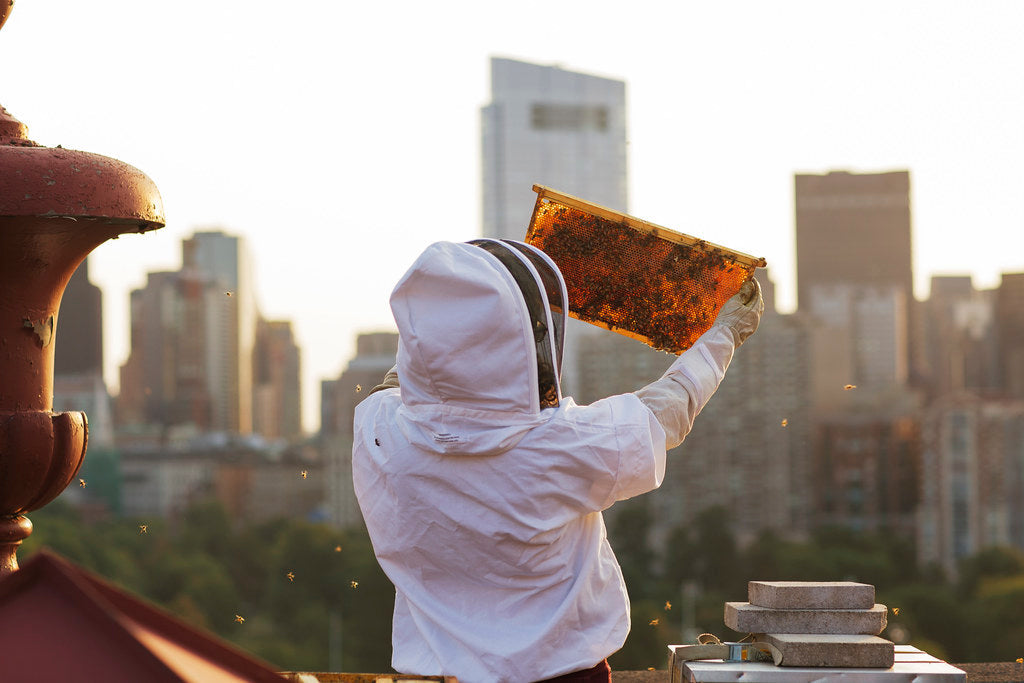
The Secret World of Urban Beekeeping: Why Our Cities Need Bees More Than Ever
Share
The Secret World of Urban Beekeeping: Why Our Cities Need Bees More Than Ever
When you think of bees, you might picture lush meadows, buzzing countryside hedgerows, or sprawling lavender fields. But increasingly, these industrious little pollinators are finding homes in a rather unlikely habitat – our cities. From the rooftops of London to the fire escapes of New York, urban beekeeping is becoming a quiet yet vital movement, driven by a surprising truth: bees might just fare better in our cities than in the countryside.
 Beehives on a London rooftop, set against the city skyline.
Beehives on a London rooftop, set against the city skyline.
Why Cities Are Surprisingly Bee-Friendly
The assumption that bees belong in the countryside is rooted in a romantic but outdated image of rural life. In reality, modern agricultural landscapes can be surprisingly hostile for bees. Monoculture farming, heavy pesticide use, and habitat loss have created vast "green deserts" where biodiversity struggles to thrive. By contrast, cities often offer a more diverse, pesticide-free buffet of flowering plants, from window boxes and balcony planters to sprawling parks and botanical gardens.
Moreover, urban areas tend to have milder microclimates – the so-called "urban heat island" effect – which can extend the flowering season and provide bees with a longer foraging period. London, for instance, supports over 4,000 registered beekeepers and tens of thousands of hives, thriving amidst the concrete and glass.
The Role of the Urban Beekeeper
Being an urban beekeeper is about far more than just harvesting honey. It's a delicate dance of observation and care, balancing the health of the hive with the needs of the surrounding community. These beekeepers become quiet custodians of the city's unseen wildlife, ensuring that their buzzing wards are well-fed and disease-free.
Most cities have strict regulations around beekeeping – for good reason. In densely populated areas, a single agitated swarm can be a public relations nightmare. However, with the right training and a respectful approach, urban beekeeping can be a remarkably low-impact, high-reward hobby.

An urban beekeeper tending to a hive on a Parisian balcony.
Bees as Biodiversity Boosters
The benefits of urban beekeeping extend far beyond honey. Bees play a crucial role in pollinating urban flora, supporting everything from community gardens to wildflowers sprouting from forgotten patches of soil. This, in turn, supports a wide range of other wildlife, including birds, small mammals, and even humans – our food supply depends on it, after all.
Interestingly, some studies suggest that urban bees might actually be healthier than their rural counterparts. A 2023 study from the University of Bristol found that city bees were exposed to fewer pesticides and had a more varied diet, which resulted in stronger immune systems and better overall hive health. This turns the common wisdom on its head and highlights the potential of cities as unexpected biodiversity hotspots.
A Sticky Business: The Realities of Urban Honey
Of course, the honey itself is a point of fascination. Urban honey can be remarkably diverse in flavour, reflecting the unique botanical footprint of each city. Hives placed near lavender, wild thyme, or even the flowering horse chestnuts of London's parks produce honey with subtle, sometimes surprising flavours – a sweet echo of the city's hidden green spaces.
However, it’s not without its challenges. Pollution can be a concern, and not every urban area is suitable for hives. Beekeepers need to be vigilant, ensuring their bees have access to clean water and uncontaminated foraging grounds.
With growing awareness of climate change and biodiversity loss, the urban beekeeping movement is set to play a critical role in future-proofing our cities. Some architects are even integrating beehives into their designs, creating 'bee hotels' on the sides of buildings or installing green roofs designed with pollinators in mind. In this way, the humble bee is helping to reshape how we think about our urban spaces – not just as places for humans, but as ecosystems in their own right.
So, the next time you see a honeybee flitting around a city park or perched on a café windowsill, take a moment to appreciate the quiet revolution buzzing away around us. Our cities may be concrete jungles, but they hold surprising potential as havens for these vital, fascinating creatures.
